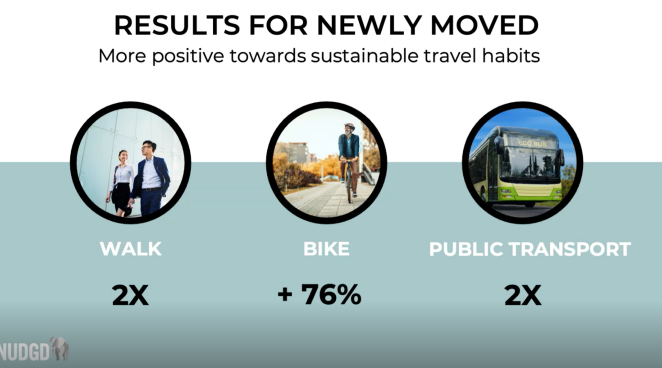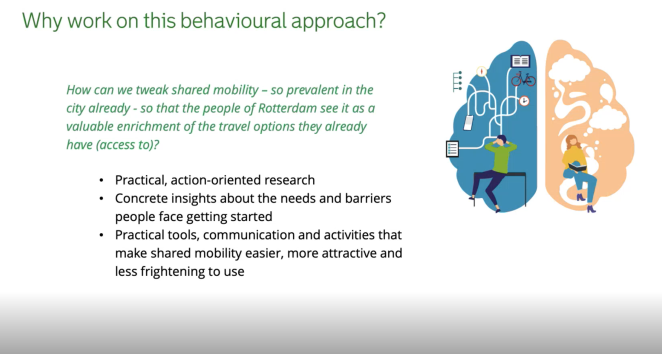Before the year ended, ShareDiMobiHub held a final thematic meeting with its partners. The focus was on improving communication and user engagement when implementing a shared and digital mobility hub strategy. The team discussed new strategies for better user interaction and digital integration, aiming to enhance the shared travel experience in their cities.
In a strategic move to shift urban travel habits towards more sustainable options, ShareDiMobiHub is launching a comprehensive initiative to promote the use of shared and digital mobility hubs. The project, encompassing collaborations with seven partner cities and regions across four North-Sea countries, is not just about infrastructure; but also, about supporting cities and regions on how to influence behavioural change. The goal is to transition from a reliance on private cars to embracing shared mobility options, thereby fostering cleaner, greener, and healthier urban environments.
Understanding that travel routines are often habitual rather than conscious choices, the project recognizes the challenge in altering these deep-rooted patterns. Most car owners are accustomed to the convenience of their vehicles, seeing little incentive to switch to shared mobility despite recognizing its potential benefits. After our thematic meetings on shared mobility markets, and digital dashboards, it was the time to address how authorities can incentivize new mobility patterns through shared mobility hubs by focusing on communication and user-engagement strategies.
To achieve this behavioural change, ShareDiMobiHub emphasizes the need for a multi-faceted approach. Providing adequate shared vehicles in strategic locations is a fundamental step, but it's not sufficient on its own. Motivating car owners to change their travel behavior involves considering other factors such as convenience, cost, accessibility, inclusiveness, and overall user experience. The thematic meeting highlighted the importance of comprehensive strategies that encompass these aspects, ensuring that shared mobility is not just available, but also attractive and practical for the different target groups

Nudging outside the ShareDiMobiHub scope
Kicking off the series of external presentations, Ola Rynge, co-founder of NUDGD, took the floor to shed light on how behavioural change can significantly impact travel choices. NUDGD, a company at the forefront of applying behavioral psychology to sustainability initiatives, focuses on 'digital nudging'. Ola introduced their flagship product, Smart Nudge, a research-backed digital platform designed to facilitate sustainable choices through a suite of nudges and best practice solutions. He emphasized the critical elements for successful nudging campaigns: personification, and timing by using the windows of change. These, combined with the courage to differentiate messaging, form the cornerstone of their approach to influencing behavior in a positive and sustainable direction.
Following Ola Rynge's insights, the dialogue shifted to the e-smartec Interreg Europe project, represented by a member from POLIS. This recently concluded project aimed to enhance mobility planning and policy making by incorporating targeted marketing strategies, bridging the gap between grassroots and top-tier decision-making. The e-smartec initiative particularly focused on raising user awareness and fostering a participatory approach, essential for co-planning Sustainable Urban Mobility Plans (SUMPs). A key aspect of their discussion was the careful calibration of user participation at every stage of policy development. E-smartec have defined various marketing techniques tailored to different stages of the project. Some of the outlined approaches range from storytelling, ideal for heightening public awareness about sustainable mobility benefits, to more dialogue-oriented techniques addressing specific issues or community inputs. The presentation summarized the e-smartec handbook, offering valuable tips on successful marketing techniques for engaging communities.
Mpact took the stage next, sharing insights from the SmartHubs project with a particular focus on vulnerable user groups. SmartHubs explores the potential of mobility hubs, especially in terms of inclusive sustainable urban mobility and accessibility, through a series of living labs across European cities. These hubs are being tested for their effectiveness in addressing the needs of diverse user groups. As emphasized by Mpact Officer, the heart of SmartHubs’ approach lies in understanding and catering to the specific needs of vulnerable populations, including migrants or ethnic minorities, digitally excluded individuals, and older adults. Factors like availability, reliability, assistance, and training are fundamental in making mobility hubs accessible and relevant to these groups. Only by being aware of these needs, developing customized communication campaigns will be possible. Such tailor-made approaches are crucial for engaging underserved communities who have not yet embraced shared mobility solutions, thereby broadening the scope and impact of shared transport systems.

How are ShareDiMobiHub partners developing their communication strategies?
The meeting transitioned to insights from their own cities and regions, following inspiring presentations from external stakeholders on innovative nudging actions and services.
Rotterdam delved into their behavioral approach towards mobility hubs. They are conducting action-oriented research to gain tangible insights into the needs and barriers faced by people, thereby crafting practical tools, communication strategies, and activities to simplify shared mobility. A critical aspect is demonstrating the personal benefits of shared mobility to citizens, not just the general advantages. Rotterdam focuses on helping residents discover these benefits and confidently overcome initial barriers to using shared mobility. The city is implementing various communication campaigns and city challenges to target behavioral change.
Amsterdam's approach began with defining clear internal and external goals. Internally, they aimed to facilitate the creation of mobility hubs amid various spatial claims and encourage area developments and maintenance projects to adopt these hubs. Externally, the focus was on acquainting residents with the concept of shared mobility and fostering acceptance of neighborhood hubs. Collaborating with the University of Amsterdam of applied sciences, they explored strategies to encourage shared mobility usage. Key outcomes included showing residents the personal benefits, like more public space and greener areas, ensuring affordability, reliability, and providing a MaaS app for service providers. Amsterdam employed various tools such as temporary hub information, informational letters to residents, and a comprehensive website detailing the benefits of hubs, their locations, and the city's strategy.
Lastly, the session highlighted Leuven's communication efforts with their Hoppin Hubs. Aiming to reduce car usage and promote sustainable mobility, Leuven's strategy aligns with Ola from NUDGD's principles, including personification through unique branding for Hoppin Hubs, clear and eye-catching signboards for rapid recognition, and other techniques like incorporating humor in campaigns and emphasizing citizen ownership and reciprocity. These diverse but cohesive approaches by ShareDiMobiHub partners underscore the significance of tailored communication and behavioral techniques in fostering the adoption of shared mobility.
In summary, the ShareDiMobiHub meeting was key to showcase diverse strategies to promote sustainable urban mobility. Each city and expert emphasized the need for tailored communication to highlight the personal benefits of shared mobility. Additionally, the discussion acknowledged the value of initiating co-creation processes, despite being time-consuming, to develop mobility hubs that meet local needs and build trust in communities, particularly in areas resistant to alternatives to privately owned vehicles. This meeting underscored the crucial role of effective communication and community involvement in driving the shift toward sustainable urban transportation.
